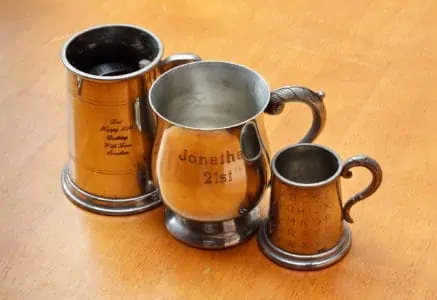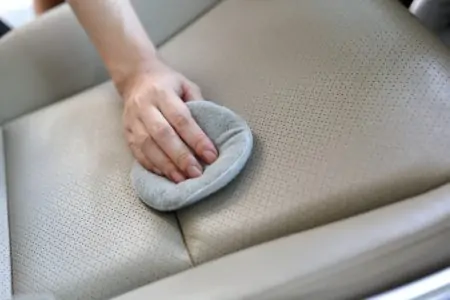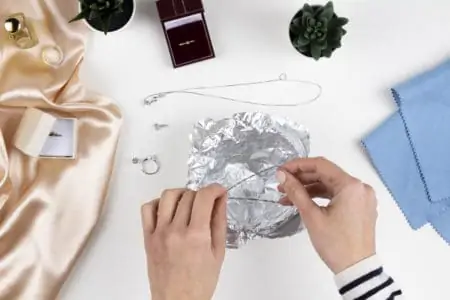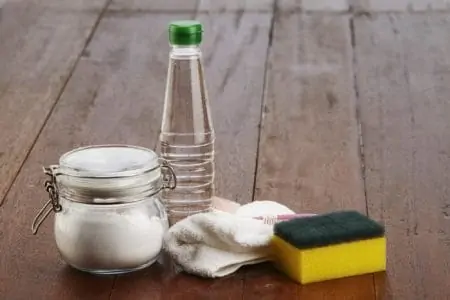If you have items made of pewter, you’re probably a bit curious — and apprehensive — about how to clean them.
After all, pewter is made to last, so it’s essential to take care of it so that it remains shiny, beautiful, and damage-free.
We’ll show you how to clean pewter items the right way. Whether you have polished, satin, or oxidized pewter, watch our methods transform the piece from dull to dazzling.
Key Takeaways
- Identify the type of pewter (polished, satin, or oxidized) before cleaning, as each type requires a different method.
- Clean pewter with warm or hot water and mild dish soap, using a soft cloth or sponge to gently rub the surface.
- Rinse the pewter under warm water and dry it with a soft towel to prevent damage.
- Polish polished pewter regularly using vinegar and flour paste, commercial pewter polish, or linseed oil and rottenstone.
Types of Pewter
There are three types of pewter. This can make up various objects around your house, such as faucets, jewelry, figurines, miniatures, dishes, bowls, antique mugs and cups, and more. You must know what kind yours is since the cleaning method for each is different.
Polished Pewter
This is the most common kind of pewter. It has a shiny finish that you must maintain with regular polishing. This pewter looks more like silver, and most people want to keep it that way. If you don’t maintain it, the pewter will dull and darken.
How often you wash it depends on how often you polish it. You must clean it before every polish. Choose how often you want to polish it based on how shiny you want it to be. If you notice that it’s looking too dull for your taste, it’s time for a clean and polish.
Satin Pewter
Satin pewter is a bit rougher than polished pewter. Satin pewter is cast with a matte patina that looks like a grainy finish. Because of this, you’ll use a lighter cleaning method to avoid damage.
You can skip polishing these pieces. But it’s important to clean them. We recommend 1-2 times a year, or whenever you notice it’s dirty.
Oxidized Pewter
Oxidized pewter is a desired “tarnished” style. To maintain this antique corrosion-style appearance, you must never polish it. It’s supposed to look dark and textured. All you need to do is dust it regularly, at least twice a month. And try to wash it when it’s dirty, or 1-2 times a year.
How to Clean Pewter
You don’t need to clean your pewter too often. But regular annual or bi-annual cleaning is important. Let’s get into the best methods to use at home.
- Time: 10-15 minutes
- Difficulty: Easy
Polished Pewter
What You’ll Need
- Mild dish soap
- Sink or basin
- Soft sponge or cloth
- Soft towel
1. Prepare Water
Fill a sink or basin up with hot water. Add a few drops of mild dish soap.
2. Clean the Pewter
Dip a cloth or sponge into the soapy water and rub the pewter piece gently. Continue until the piece is visibly clean.
3. Rinse
Run the piece under a gentle stream of warm water to rinse off the soapy residue.
4. Dry
Dry the polished pewter with a soft towel.
Satin Pewter
What You’ll Need
- Mild dish soap
- Sink or basin
- Soft sponge or cloth
- Soft towel
- Salt (optional)
- Steel wool (optional)
1. Prepare Water
Fill a sink or basin with hot water and a few drops of dish soap.
2. Clean the Pewter
Dip a cloth or sponge into the soapy water and apply it to the pewter. Gently rub it until it’s clean.
3. Rinse
Rinse the piece under warm water to remove any soapy residue.
4. Dry
Buff dry with a soft towel.
5. Remove Stains (Optional)
If you need to deep-clean your satin pewter, you can make a salt paste by creating a 3:1 ratio of salt and water. Apply it to the pewter piece using your fingers. Gently rub it in to remove stains.
Never use this method on polished or oxidized pewter.
Only use this method once a year. If you do it more often, you could damage the finish.
Oxidized Pewter
What You’ll Need
- Mild dish soap
- Sink or basin
- Soft sponge or cloth
- Soft towel
1. Prepare Water
Fill a sink or basin with warm water and a few drops of mild dish soap.
2. Clean the Pewter
Dip a cloth or sponge into the warm soapy water and apply it to the pewter. Rub gently until the piece is clean.
3. Rinse
Rinse the piece under warm water.
4. Dry
Buff dry with a soft towel.
How to Polish Pewter With Vinegar
It’s important to polish your polished pewter regularly. (Say that 10 times fast!) You can also polish satin pewter using a different method.
- Time: 1 hour
- Difficulty: Easy
Polished Pewter
For polishing pewter, you can use various materials. One option is mixing one cup of distilled white vinegar with ½ cup white flour to create a paste. If you want to polish naturally, that’s a great choice. Another option is a commercial pewter polish. You could also use linseed oil and rottenstone (tripoli). It’s completely up to you!
What You’ll Need
- Polishing solution (choose from the above options)
- Bowl
- Spoon
- Polishing cloth
- Saucepan (optional)
- Soft towel
- Soft cloth
1. Prepare Polish
If you’re using the flour and vinegar method, combine the two ingredients in a bowl. Mix well to create a paste.
If using a commercial polish, follow the instructions on the packaging. It might need to be diluted, but it also might be fine straight from the bottle.
If you’re using the linseed oil and rottenstone method, heat ¼ cup of linseed oil in a saucepan. When it’s warm but not too hot, add ½ cup of rottenstone and stir well to create a paste.
2. Apply Polish
Use a polishing cloth to apply the polish to the pewter. Move in small circular motions. Once you’ve covered the entire piece, leave the polish for 30 minutes to dry.
3. Rinse
After the polish has set, rinse the pewter under warm water to wash away excess residue. Wipe the pewter gently with a soft cloth to remove the paste.
4. Dry the Pewter
Use a soft towel to dry the pewter well. Remove all moisture. Leave the pewter to air dry further before checking that all of the paste or oil has been removed. If not, rinse it again.
Satin Pewter
You can polish satin pewter with steel wool, but only do this once a year; otherwise, you could damage the finish.
What You’ll Need
- Steel wool
1. Clean the Pewter
Before beginning, clean the pewter using the above method.
2. Rub With Steel Wool
Once the pewter is dry, gently rub the piece with steel wool. This will remove build-up and stains while adding a nice polish.
Always move in the direction of the grain and scrub gently to avoid scratching.
How to Clean Pewter Jewelry
Here’s the best method for cleaning pewter jewelry:
- Dampen a cloth: Dampen a cloth in warm water. Wring out the excess.
- Apply soap: Apply a mild dish soap directly to the cloth. Rub the cloth together to suds up the soap.
- Rub jewelry: Gently rub the pewter jewelry with the soapy cloth as to avoid damaging the pewter.
- Rinse: Rinse the cloth out and dampen it again with clean water. Wipe the jewelry down to remove the soap residue.
- Dry: Gently wipe the jewelry with a separate dry cloth to remove excess moisture.
How to Get Rid of Mold in Pewter
If you have black spots on your pewter, it’s most likely mold or mildew.
To remove mold, you can use the general cleaning method with warm soapy water. The only difference is using a soft scrubbing brush, such as an unused toothbrush, to scrub the pewter well. This will help lift off mold completely.
What to Avoid When Cleaning Pewter
The primary method for cleaning pewter is using warm soapy water. Pewter is a sensitive metal, so keeping it simple is best. Here are some things you should absolutely avoid when cleaning pewter:
- Abrasive cleaners: Don’t use anything that could scratch the pewter. This means avoid both abrasive cleaning solutions and scrubbing sponges.
- Acidic cleaners: Avoid acidic cleaners such as soda. Vinegar is acidic, which is why we only recommend using it for polishing polished pewter. Even then, it’s diluted with flour.
- Strong detergents: Mild dish soap is best. Don’t use harsh or strong detergents.
- Dishwasher: Don’t pop your pewter pieces in the dishwasher. The dishwasher’s high heat, detergent, and agitation can easily damage the pewter.
- Wrong polish: If using a commercial polish, make sure it’s specifically for pewter. Don’t grab one for silver, as this can damage your pewter piece.
How to Fix Pewter Ruined In a Dishwasher
You might be reading our dishwasher tip from above and thinking, “Oh no… I’ve already put my piece through the dishwasher.” If it’s now damaged, there is a method that you can use to try to restore the finish on the pewter.
However, the best option is to take the piece to a professional. They can try to fix it for you.
- Time: 1.5 hours
- Difficulty: Easy/Intermediate
What You’ll Need
- Mild dish soap
- Sink or basin
- Soft sponge or cloth
- Soft towel
- Chosen polish (for polished pewter)
- Steel wool (for satin pewter)
- Fine grade emery paper (for any pewter)
1. Clean Pewter
Follow the cleaning method from above. Make sure that you use the method that corresponds with the type of pewter you have. Keep the piece upright while it’s drying to avoid further warping.
2. Polish Pewter
If you have polished pewter, use the polishing method from above.
For satin pewter, you can polish it using the steel wool method.
3. Polish With Emery Paper
No matter what type of pewter you have, if it requires a little more effort to fix the finish, you can use fine-grade emery paper. Rub it very gently over the pewter in the direction of the grain. You might need to do this a few times to get the pewter looking good again.
Keep In Mind
If the dishwasher caused heat damage, then it’s likely your pewter piece is beyond repair.
Tips For Caring For Pewter
Besides cleaning your pewter properly, here are some other top tips for taking care of your pewter:
- Store correctly: You can keep your pewter on display or in a well-cushioned storage box. Just make sure that it isn’t near high heat sources, in hot places (such as an attic), or in a humid storage facility. Heat can quickly damage pewter.
- Dust regularly: Use a lightweight feather duster to dust your pewter pieces regularly. This removes surface-level dust and debris and keeps the pewter in a good condition.
- Wrap in tissue paper: When storing or transferring your pewter with other items, always wrap it in a few layers of tissue paper to avoid scratches or damage. You should also do this when stacking pewter pieces.
- Store upright: When your pewter piece is in storage, keep it upright instead of flat. This prevents warping.
FAQs
Keeping Pewter Pristine
Pewter is very easy to maintain if you do it properly. It’s easy to clean and won’t tarnish or rust, making it a durable material.
However, you have to clean it using specific methods. It should only be cleaned using warm or hot water and mild dish soap. Always check what type of pewter you have to use the correct method.
If in doubt, take your pewter piece to a professional. They’d be happy to help.











